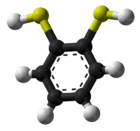1,2-Benzenedithiol
 | |
 | |
| Names | |
|---|---|
| Preferred IUPAC name
Benzene-1,2-dithiol | |
| Other names
1,2-Dimercaptobenzene | |
| Identifiers | |
| 3D model (JSmol) |
|
| ChemSpider | |
| ECHA InfoCard | 100.037.740 |
| PubChem CID |
|
| |
| |
| Properties | |
| C6H6S2 | |
| Molar mass | 142.24 g/mol |
| Appearance | colourless liquid |
| Density | 1.236 g/mL |
| Melting point | 22 to 24 °C (72 to 75 °F; 295 to 297 K) |
| Boiling point | 119 to 120 °C (246 to 248 °F; 392 to 393 K) at 17 mmHg |
| Soluble in basic water | |
| Hazards | |
| Main hazards | stench |
| Flash point | 104.0 °C; 219.2 °F; 377.1 K |
| Except where otherwise noted, data are given for materials in their standard state (at 25 °C [77 °F], 100 kPa). | |
| | |
| Infobox references | |
1,2-Benzenedithiol is the organosulfur compound with the formula C6H4(SH)2. This colourless viscous liquid consists of a benzene ring with a pair of adjacent thiol groups. The conjugate base of this diprotic compound serves as chelating agent in coordination chemistry and a building block for the synthesis of other organosulfur compounds.[1]
Synthesis
The compound is prepared by ortho-lithiation of benzenethiol using butyl lithium (BuLi) followed by sulfidation:[2]
- C6H5SH + 2 BuLi → C6H4SLi-2-Li + 2 BuH
- C6H4SLi-2-Li + S → C6H4(SLi)2
- C6H4(SLi)2 + 2 HCl → C6H4(SH)2 + 2 LiCl
The compound was first prepared from 2-aminobenzenethiol via diazotization.[3] Alternatively, it forms from 1,2-dibromobenzene.[4]
Reactions
Oxidation mainly affords the polymeric disulfide. Reaction with metal dihalides and metal oxides gives the dithiolate complexes of the formula LnM(S2C6H4) where LnM represents a variety of metal centers, e.g. (C5H5)2Ti. Ketones and aldehydes condense to give the heterocycles called dithianes:
- C6H4(SH)2 + RR’CO → C6H4(S)2CRR’ + H2O
Related compounds
3,4-Toluenedithiol, also called dimercaptotoluene (CAS#496-74-2), behaves similarly to 1,2-benzenedithiol but is a solid at ambient temperatures (m.p. 135-137 °C).
Alkene-1,2-dithiols are unstable, although metal complexes of alkene-1,2-dithiolates, called dithiolene complexes, are well known.[1]
References
- 1 2 Karlin, K. D.; Stiefel, E. I., Eds. “Progress in Inorganic Chemistry, Dithiolene Chemistry: Synthesis, Properties, and Applications” Wiley-Interscience: New York, 2003. ISBN 0-471-37829-1
- ↑ D. M. Giolando; K. Kirschbaum (1992). "An efficient one-pot synthesis of 1,2-benzenedithiol from benzenethiol". Synthesis: 451–452. doi:10.1055/s-1992-26132.
- ↑ P. C. Guha and M. N. Chakladar (1925). J. Indian Chem. Soc. 2: 318.
- ↑ Aldo Ferretti. "1,2-Dimercaptobenzene". Org. Synth.; Coll. Vol., 5, p. 419